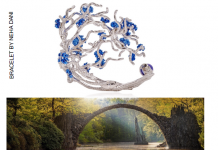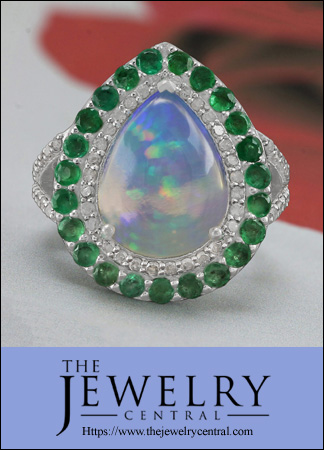 A Turkish Delight
A Turkish Delight
When shopping for a gemstone, you are faced with an array of amazingly diverse choices, with as many different colors, cuts and countries of origin to choose from as there are individual styles. As a bridge between two cultures, Turkey is a unique blend of East and West. The birthplace of major civilizations, including the Byzantine and Ottoman Empires, despite Chalcedony Quartz’s name being derived from Chalcedon, an ancient port near present day Istanbul, Turkey is not usually a country associated with gemstones, until now.
 Relatively new to the jewelry world, Zultanite is one gemstone whose amazing natural color changing abilities makes it well suited to savvy jewelry connoisseurs. As you watch its colors change from kiwi to champagne to raspberry, you too will be entranced by Zultanite’s 100% natural beauty. The pinnacle of exclusivity, beauty, rarity and desirability, Zultanite is a rising star in fine jewelry due to its sparklingly brilliant tranquil colors. Like Tanzanite, Zultanite is so rare that it comes to you from only one source in the world, a remote mountain area in Anatolia, Turkey. Named by Murat Akgun in honor of the 36 sultans who ruled the Ottoman Empire in Anatolia in the late 13th century, Zultanite is a true Turkish delight.
Relatively new to the jewelry world, Zultanite is one gemstone whose amazing natural color changing abilities makes it well suited to savvy jewelry connoisseurs. As you watch its colors change from kiwi to champagne to raspberry, you too will be entranced by Zultanite’s 100% natural beauty. The pinnacle of exclusivity, beauty, rarity and desirability, Zultanite is a rising star in fine jewelry due to its sparklingly brilliant tranquil colors. Like Tanzanite, Zultanite is so rare that it comes to you from only one source in the world, a remote mountain area in Anatolia, Turkey. Named by Murat Akgun in honor of the 36 sultans who ruled the Ottoman Empire in Anatolia in the late 13th century, Zultanite is a true Turkish delight.
A gem that changes color?
 Color change gems show different colors when viewed under different light sources, such as sunlight and indoor light. Astonishingly beautiful, exotic and rare, Zultanite demands a double take – its unique color change is truly that mesmerizing. If for you fashion is all about getting attention, Zultanite is set to redefine your look.
Color change gems show different colors when viewed under different light sources, such as sunlight and indoor light. Astonishingly beautiful, exotic and rare, Zultanite demands a double take – its unique color change is truly that mesmerizing. If for you fashion is all about getting attention, Zultanite is set to redefine your look.
 While some of Zultanite’s key characteristics are its delicate color saturation, durability and scintillation (play of light), the beauty and intrigue of this regal gemstone ultimately lies in its different colors. Zultanite displays a range of earthy hues and similar to the famous color change gem Alexandrite, it can change from kiwi greens in sunlight (candescent light) to raspberry purplish-pinks in candlelight (incandescent light). But unlike other color change gems such as Alexandrite, Zultanite’s color change is not limited to two basic colors. Incredibly, the same Zultanite can also exhibit khaki greens, sage greens, cognac pinks, pinkish champagnes, canary yellows, rich champagnes and gingers in different light sources. Zultanite’s kiwi greens with canary flashes are noticeable under sunny skies, while traditional indoor lighting will elicit rich champagne colors. During a candle lit dinner, the same gem reveals pink to raspberry hues. While just wearing Zultanite unveils its breathtakingly diverse colors, one of its most unique characteristics is that unlike other color changes gems, Zultanite’s best color change is not dependant on dark tones. According to the leading gemstone author Antoinette Matlins, some women prefer the colors of Zultanite because they like the more subtle pastel contrast and find they complement earth tones (green, chocolate, mocha and gold), making the gem more wearable. Like all color change gemstones, the larger the Zultanite, the more visible the color change.
While some of Zultanite’s key characteristics are its delicate color saturation, durability and scintillation (play of light), the beauty and intrigue of this regal gemstone ultimately lies in its different colors. Zultanite displays a range of earthy hues and similar to the famous color change gem Alexandrite, it can change from kiwi greens in sunlight (candescent light) to raspberry purplish-pinks in candlelight (incandescent light). But unlike other color change gems such as Alexandrite, Zultanite’s color change is not limited to two basic colors. Incredibly, the same Zultanite can also exhibit khaki greens, sage greens, cognac pinks, pinkish champagnes, canary yellows, rich champagnes and gingers in different light sources. Zultanite’s kiwi greens with canary flashes are noticeable under sunny skies, while traditional indoor lighting will elicit rich champagne colors. During a candle lit dinner, the same gem reveals pink to raspberry hues. While just wearing Zultanite unveils its breathtakingly diverse colors, one of its most unique characteristics is that unlike other color changes gems, Zultanite’s best color change is not dependant on dark tones. According to the leading gemstone author Antoinette Matlins, some women prefer the colors of Zultanite because they like the more subtle pastel contrast and find they complement earth tones (green, chocolate, mocha and gold), making the gem more wearable. Like all color change gemstones, the larger the Zultanite, the more visible the color change.
As if one phenomena wasn’t enough, some Zultanite also possess the coveted cat’s eye effect. Chatoyancy or the cat’s eye effect is a reflection effect that appears as a single bright band of light across the surface of a gemstone. It is caused by the reflection of light by parallel inclusions.
 The GIA (Gemological Institute of America) classifies Zultanite as a Type II transparent gemstone, meaning that it is usually eye-clean (no visible inclusions when the gem is examined approximately 6 inches from the naked eye) with some inclusions visible under 10x magnification. Inclusions are tiny natural features that grow within the crystal during a gem’s formation within the earth. Mostly microscopic in nature, inclusions are a fascinating hallmark of authenticity, recording a gem’s natural relationship with the earth. They are also extremely useful to gemologists when identifying natural gemstones from synthetics and imitations.
The GIA (Gemological Institute of America) classifies Zultanite as a Type II transparent gemstone, meaning that it is usually eye-clean (no visible inclusions when the gem is examined approximately 6 inches from the naked eye) with some inclusions visible under 10x magnification. Inclusions are tiny natural features that grow within the crystal during a gem’s formation within the earth. Mostly microscopic in nature, inclusions are a fascinating hallmark of authenticity, recording a gem’s natural relationship with the earth. They are also extremely useful to gemologists when identifying natural gemstones from synthetics and imitations.
Zultanite registers 7 out of 10 on the Mohs’ Hardness Scale (a system devised in the 18th century by a Viennese mineralogist Friedrich Mohs to measure the ability of a gem to resist surface scratching), has a refractive index of 1.75 and specific gravity of 3.39. Unless you’re a gemologist, these numbers won’t mean much to you, but these characteristics make Zultanite an excellent jewelry gemstone. As 100% natural gemstone, Zultanite is one of the few gems that have no known enhancements or treatments.
While the newness of Zultanite means that it has had little time to accumulate legends and lore, for those interested in the esoteric properties attributed to gemstones, some people believe Zultanite can assist in the development of psychic power, astral force, ambition, intellect, desire and emotions based on intellect and touch.
Zultanite not diaspore
 First faceted in the late seventies (1977), Zultanite is an extremely rare gemstone that despite its beauty and suitability for jewelry was previously plagued by scant availability. While an article in “Gems & Gemology” magazine (Winter 1994) indicated that supplies were promising, this hasn’t translated into the availability of good quality gems until recently. While some jewelers previously sourced limited quantities of this gem marketed under their mineral name Diaspore, please don’t confuse the two. Zultanite is your guarantee that each gem has been optimally cut by some of the world’s most experienced lapidaries.
First faceted in the late seventies (1977), Zultanite is an extremely rare gemstone that despite its beauty and suitability for jewelry was previously plagued by scant availability. While an article in “Gems & Gemology” magazine (Winter 1994) indicated that supplies were promising, this hasn’t translated into the availability of good quality gems until recently. While some jewelers previously sourced limited quantities of this gem marketed under their mineral name Diaspore, please don’t confuse the two. Zultanite is your guarantee that each gem has been optimally cut by some of the world’s most experienced lapidaries.
Zultanite’s mineral name “Diaspore”, comes from the Greek word “diaspora” meaning “to scatter”. While Diaspore was first discovered in 1801 in Mramorskoi, Kossoibrod, Ural Mountains, Russia, the Turkish deposit remains the world’s only source of Zultanite.
All gems are rare, but some are rarer than others
By their very definition, all gemstones are rare (to be classed as a gem, a mineral or organic material used for personal adornment must be rare, beautiful and durable), but like many things, rarity is relative. Apart from their color change and discovery in Russia’s Urals (Alexandrite was discovered in Russia’s Ural Mountains in 1834), Alexandrite and Zultanite’s names both have royal connections, Zultanite being named in honor of Ottoman sultans and Alexandrite being named for a Russian tsar, but which is rarer? While comparative rarity is always difficult to gauge, in terms of natural occurrence, Zultanite is far rarer. Zultanite is only mined in one country, while Alexandrite is currently mined in seven.
Although it was initially collected by mineral enthusiasts and independent miners in the mid eighties, Zultanite is now mined commercially. Mined by hand with chisels and pick-axes in Turkey’s Anatolian Mountains (Milas county of Muğla) at a height of over 4,000 feet, the world’s only Zultanite deposit is 7 miles away from the nearest village of Selimiye. But its rarity isn’t just dictated by its natural scarcity and remoteness, Zultanite tests the skills of even experienced cutters due to the difficultly in correctly orientating each crystal to accentuate its inherent color change. With up to 98% of the crystal lost during cutting, its unbelievably low yield (2%) really reinforces the exclusivity of this truly beautiful gemstone and is one of the reasons Zultanite is so rare, especially in sizes over 5 carats.
Brilliant, mesmerizing and fashionable, phenomenal Zultanite is a rare star in fine jewelry design, deserving pride of place in every serious jewelry collection.


















